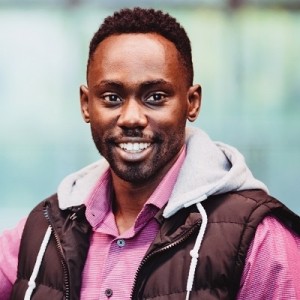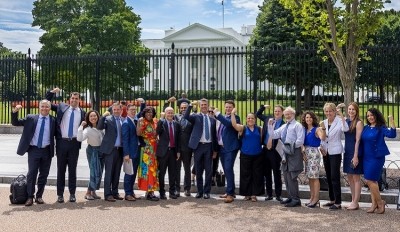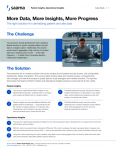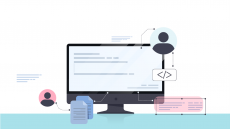RWE can boost trial acceleration, cost efficiency, and inclusivity

The clinical research field is witnessing a rapid evolution in data collection and analysis. One of the advances is the increased use of real-world evidence (RWE) to help elevate trial design and execution.
Outsourcing-Pharma recently spoke with Kwame Marfo, general manager of clinical development at Komodo Health, to discuss some of the notable advancements and some of the ways the wealth of data could be put to better use.
OSP: Could you please share the ‘elevator presentation’ of Komodo Health—who you are, what you do, and what sets you apart from other companies working in this sphere?
KM: Komodo Health’s technology platform and software solutions allow life sciences companies, health plans, advocacy groups, and other healthcare stakeholders to track detailed patient behaviors and treatment patterns using real-world patient data to unlock critical strategic insights.
For example, life sciences companies will use Komodo Health to quickly identify trends in specific diagnoses, treatment patterns, or care intervention points that are important triggers for physician outreach and engagement. Similarly, clinical development teams can use the technology to improve patient recruitment for clinical trials by identifying patients with specific diagnoses or patterns of treatment, while commercial teams can use Komodo Health software to optimize their HEOR processes.
Disease advocacy groups use Komodo Health to help patients find doctors in their areas who’ve had the most success treating patients. Digital marketing agencies and technology companies partner with Komodo Health to optimize their patient outreach strategies.
OSP: You talk about clinical trial design needing to be overhauled. Could you please talk about some of the most pressing challenges and shortcomings with the way things are?
KM: Clinical trials have brought us so many life-saving therapeutics but the reality is that historically, the data that feeds into the decision-making around trial design has not been siloed and not fully representative of all patients afflicted by disease. Understanding the real-world journeys and experiences of patients at a population level can better inform decisions around designing and executing trials for maximum impact and mitigating risks for different subpopulations.
The randomized control trial continues to be the gold standard for scientific research, but we have to appreciate what this means in human terms if the control arm is a placebo or ineffective standard of care.
The data and the technology exist today to create robust control arms by integrating real-world data or by tracking the real-world experiences of patients who are not a part of the clinical trial. The concept of a synthetic control arm made up entirely of real-world data collected from the patient journeys of thousands – sometimes hundreds of thousands – of patients out in the world introduces a less expensive, more representative, faster, and far more humane way of creating control arms.
OSP: Could you please share an overview of how RWE might provide some solid solutions for what’s currently wrong with trial design?
KM: Today, roughly 80% of clinical trials fail to meet enrollment timelines and requirements. Of those that do make it to Phase II, about 70% never make it to Phase III. There are many reasons for this: study design flaws, lack of funding, and inadequate efficacy are among the most common. But there is one big problem that cuts across all of these and creates an unnecessary barrier to new drug development: structural inefficiency.
The physical process of running a clinical trial, from site selection to physician engagement to patient recruitment has been a largely manual process, ripe for reinvention. RWE allows clinical teams to target research and recruitment based on highly specific constellations of symptoms and diagnoses; it supports more comprehensive HEOR and comparative effectiveness analytics. The data makes it possible to see the complete clinical picture so life sciences teams can go into a trial with eyes wide open.
OSP: More specifically, how can RWE save time?
KM: Take patient recruitment as an example. The conventional method of identifying and selecting patients for a trial through a mix of historic trial data, patient surveys, and relationships with providers and advocacy groups often misses eligible patient populations due to the inherent lag time in the data and the limited scope of data sources used. In the case of rare diseases or quickly progressing, high mortality diseases like cancer, this process is tantamount to finding needles in a haystack.
Data is often incomplete, inaccurate, and out-of-date, and the process of actually getting from that data to recruiting enough patients for a trial consumes a significant portion of the total cost of a trial, which can range from $1.4m to $6.6m for a Phase I study.
Today, using RWE, it is possible in a matter of minutes to create an accurate map of individual patient journeys at scale, capturing real-time data and real-world touchpoints with the healthcare system to understand the full spectrum of patient experience as it’s happening.
OSP: Recruiting and retaining a sufficiently representative patient population continues to be a serious issue that sites and sponsors struggle with—how can RWE help elevate trial inclusivity?
KM: Again, part of the problem with the current status quo is structural. It’s a function of the way clinical trials have historically been designed. That has historically meant building a clinical trial around a key opinion leader, who is most likely going to be working at a major teaching hospital in a large metro area.
By definition, that focus will limit recruitment to people who live in a certain radius of those major research institutions. So, you’re subject to the demographics of those cities. You also have socioeconomic concerns like the ability to get to the trial, ability to take time off, etc. which can limit involvement for certain underrepresented groups.
By designing the trial around RWE, the calculus on patient recruitment and location flips from a focus on KOLs to a focus on providers who are seeing the largest number of patients with a particular condition. RWE creates a very patient-centric approach to trial recruitment, which is a much more equitable way to think about the process.
OSP: You cite Medicenna’s MDNA55 as an example of a drug whose progress was made possible with RWE—could you tell us a bit about that?
KM: The FDA approved the use of a hybrid external control as part of the ongoing development of MDNA55, combining synthetic controls and randomized patients. But that’s what’s so exciting about the current point in time. The FDA is starting to recognize RWE as sufficient evidence to support approvals for certain indications. In fact, the FDA issued draft guidance late last year on the use of RWE to support regulatory decision-making and has been approving drugs for certain indications based on real-world data.
There was another exciting example with Ibrance, a Pfizer drug approved for treating metastatic breast cancer in women. Doctors had been prescribing it off-label to treat male breast cancer patients who had the same phenotype as female patients, and – based on the overwhelming evidence in the data – the FDA authorized the use of Ibrance for male breast cancer without a clinical trial. Those are big breakthroughs!
OSP: Please tell us how a company like Komodo can empower clinical trial companies to improve their trial design with the use of RWE, synthetic control arms, and other advanced tools.
KM: This is what we’re doing every day. We’re currently working with several of the largest life sciences companies on aspects of clinical trial design, site/investigator selection, recruitment, and HEOR using our software and robust RWE database to improve the accuracy, speed, and cost-effectiveness of the drug development process. We are giving life sciences companies the software and tools they need to build truly patient-centric drug development strategies.
OSP: Do you have anything to add?
KM: The infusion of real-world data into Life Sciences companies can have a dramatic impact on healthcare decision-making, and we’ve only just scratched the surface of its potential. The use of RWE for things like connecting clinical trial data with real-world data can lead to richer insights before, during, and after the trial.
There were over 37,000 registered clinical trials last year. Imagine a world where the design and execution strategies of these trials were supported by RWE. They could be more informative, effective, faster, and/or representative
In time, we hope to see that RWE is able to not only optimize and accelerate trial phases but also offer new capabilities and replace legacy processes.



















